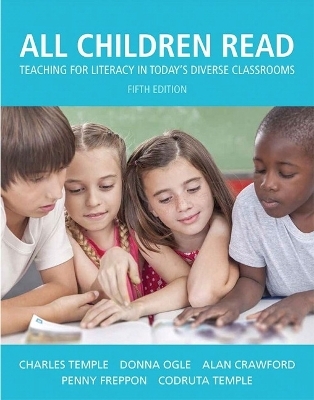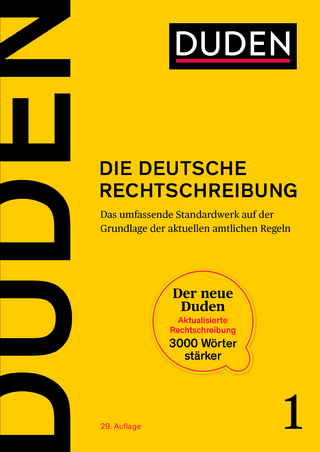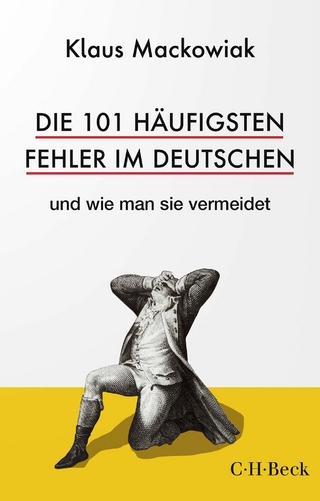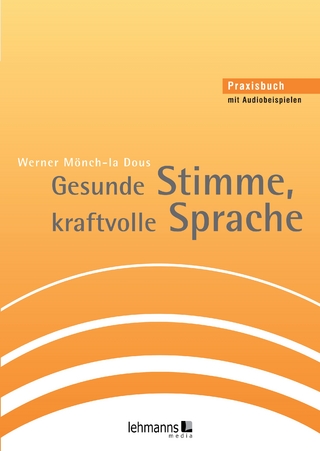
All Children Read
Pearson (Verlag)
978-0-13-489465-2 (ISBN)
- Titel z.Zt. nicht lieferbar
- Versandkostenfrei innerhalb Deutschlands
- Auch auf Rechnung
- Verfügbarkeit in der Filiale vor Ort prüfen
- Artikel merken
Written by one of the most dynamic author teams in the field of reading and literacy, All Children Read, Fifth Edition, continues to offer K-8 teachers the best practices for developing reading and writing in all students. As with earlier editions, six critical themes are interwoven throughout: the struggling reader; family/community literacy; new literacies; writing and reading connections; developmental, cultural, and linguistic diversity; and phonics/phonological awareness. The fifth edition further integrates Common Core State Standards and Response to Intervention (RTI), includes separate chapters on teaching reading fluency and vocabulary, emphasizes the teaching of English Learners, and equips teachers-in-training with the foundational knowledge they will need for their professional qualifying examinations. This focus on contemporary and critical learning prepares future teachers for the demands of helping all students succeed in the classroom.
Also available with Revel
Revel™ is Pearson’s newest way of delivering our respected content. Fully digital and highly engaging, Revel replaces the textbook and gives students everything they need for the course. Informed by extensive research on how people read, think, and learn, Revel is an interactive learning environment that enables students to read, practice, and study in one continuous experience—for less than the cost of a traditional textbook.
Note: You are purchasing a standalone product; Revel does not come packaged with this content. Students, if interested in purchasing this title with Revel, ask your instructor to confirm the correct package ISBN and Course ID. Instructors, contact your Pearson representative for more information.
If you would like to purchase both the physical text and Revel, search for:
0134995147 / 9780134995144 All Children Read: Teaching for Literacy in Today's Diverse Classrooms, with Revel -- Access Card Package
Package consists of:
0134894650 / 9780134894652 All Children Read: Teaching for Literacy in Today's Diverse Classrooms
0134515978 / 9780134515977 Revel All Children Read: Teaching for Literacy in Today's Diverse Classrooms -- Access Card
CHARLES TEMPLE is a professor of education at Hobart and William Smith Colleges in Geneva, New York, where he teaches courses on literacy, children’s literature, storytelling, and international education. He has written books on emergent literacy, invented spelling, writing instruction, language arts, diagnosis and remediation of reading disabilities, and children’s literature, as well as books for children. He codirects Critical Thinking International, Inc., a nonprofit organization that does children’s book development and literacy work around the world. DONNA OGLE is Emerita Professor of Reading and Language at National-Louis University (NLU) in Chicago, Illinois, and is active in research and professional development projects. She served as senior consultant to the Chicago Striving Readers Project, was CoDirector of the Literacy Partners Project, and codirects the Reading Leadership Institute. Donna also serves as a literacy consultant internationally and is part of Critical Thinking International and an editorial reviewer for Grupo SM in Latin America, The Reading Teacher, and the Journal of Adolescent and Adult Literacy. Donna is a past president of the International Reading Association (IRA) and an elected member of the Reading Hall of Fame. She is the author of many books, book chapters, professional articles, and curriculum materials. ALAN CRAWFORD is Emeritus Professor of Education at California State University, Los Angeles. He has served as President of the California Reading Association, a Fulbright Senior scholar in Ecuador and Morocco, and a Researcher in Residence at the American Embassy in Baku, Azerbaijan. He has done extensive teaching, consulting, and writing on teaching reading in the elementary school, especially for second language learners. Alan has written curriculum for teaching reading in Spanish and served on the Editorial Review Board of Lectura y Vida. He served as IRA’s representative to UNESCO for many years and was a Senior Literacy Specialist at UNESCO in Paris during International Literacy Year (1989—90). He is currently a director of Critical Thinking International. He frequently presents seminars and workshops on a volunteer basis for international development projects in Latin America, Europe, Asia, and Africa. CODRUTA TEMPLE is associate professor of second language education at the State University of New York College at Cortland. She has coauthored two college textbooks, The Beginnings of Writing and Understanding Reading Problems: Assessment and Instruction, as well as several articles and book chapters on literacy development in mathematics classrooms.
Brief Table of Contents
Approaches to Teaching Reading
The Social and Cultural Contexts for Teaching All Children to Read
What Reading Teachers Need to Know About Language
Emergent Literacy
Phonics and Word Knowledge
Helping Readers Build Fluency
The Importance of Vocabulary Development
Reading Comprehension, Part I: Making Sense of Literature
Reading Comprehension, Part II: Understanding and Learning with Informational Texts
Critical Thinking and Critical Literacy
Teaching Children to Spell and Write
Assessing Literacy
Integrating Language and Literacy Instruction Across the Grades
Models and Strategies for Teaching ESL and for Teaching Reading in the Mother Tongue
Appendix A: Addressing the Common Core Standards Appendix B: Teach It! Instructional Activities References Glossary Name Index Subject Index Detailed Table of Contents
Approaches to Teaching Reading
Why Does Literacy Matter?
How Well Do Children in the United States Read?
Components of Reading Ability
Phases of Reading Development
The Recent History of Reading Instruction: How WeGot Where We Are
The Social and Cultural Contexts for Teaching All Children to Read
The Social Contexts of Literacy
Planning for a Literate Classroom
Meeting the Literacy Needs of All Children
Response to Intervention (RTI)
Finding the Books and Materials TheyWant to Read
What Reading Teachers Need to Know About Language
Phonology: The Sounds of English
Morphology: How English Words Are Built
Vocabulary: Words and Their Meanings
Syntax: Ordering and Inflecting Classes of Words
Text Structure
Emergent Literacy
What Is Emergent Literacy?
Language-Based Learning and Emergent Literacy
Print-Based Learning and Emergent Literacy
Comprehensive Strategies to Nurture Emergent Literacy
Teaching Specific Skills
Environmental Strategies to Support
Emergent Literacy
Involving Families in Emergent Literacy
Phonics and Word Knowledge
What Is Phonics? What Is Word Knowledge?
Words as Wholes: The Logographic Phase
Letter-by-Letter Reading: The Alphabetic Phase
Chunking: The Orthographic Phase
Meaningful Word Parts: The Morphological Phase
Word Histories and Families: The Derivational Phase
Helping Students Read Words in Context
Helping Readers Build Fluency
Fluency in Reading
Modeling Fluent Oral Reading
Supporting Children’s Reading for Fluency
Practicing Fluency With and Without the Teacher’s Guidance
Embedding Repeated Reading in Performance
The Importance of Vocabulary Development
What Is Vocabulary?
What Does the Research Say About Vocabulary?
Teaching Vocabulary
Teaching Strategies for Independent Word Learning
Reading Comprehension, Part 1: Making Sense of Literature
How Students Understand Literature
Teaching for Comprehension: General Strategies
Teaching for Comprehension: Specific Skills
Close Reading
Assessing Comprehension
Reading Comprehension, Part II: Understanding and Learning with Informational Texts
Characteristics of Informational Texts
Understanding How Readers Comprehend Informational Texts
Teaching Students to Use Features of Informational Texts
Teaching with Informational Texts
Classrooms That Develop Independent Learners
Critical Thinking and Critical Literacy
Critical Thinking and Critical Literacy
Looking Critically at Works of Literature
Thinking Critically About Texts Other Than Stories
Teaching Strategies for Critical Thinking
Teaching Children to Spell and Write
Spelling Development and Assessment
Teaching Children to Spell
A Writing Process in Five Parts
Writing in Different Genres
Assessment of Writing
Writing to Learn
Assessing Literacy
What Is Assessment and Why Do We Assess?
Approaches to Assessment
Terms Used in Testing
Assessing Emergent Readers
Assessing Beginning Readers and Beyond
Other Uses of Assessment
Integrating Language and Literacy Instruction Across the Grades
Teaching Print Concepts and Phonological Awareness in Context
Teaching Phonics in Context
Teaching Morphology in Context
Teaching Grammar in Context
Teaching Text Structure
Models and Strategies for Teaching ESL and for Teaching Reading in the Mother Tongue
Options for Teaching the English Language Learner
Major Principles of Second-Language Acquisition
Instructional Strategies for Second-Language Acquisition
Options for Teaching the English Language Learnerto Read
Mother Tongue Support in the Bilingual Classroom
Appendix A: Addressing the Common Core Standards Appendix B: Teach It! Instructional Activities References Glossary Name Index Subject Index
| Erscheinungsdatum | 08.04.2018 |
|---|---|
| Sprache | englisch |
| Maße | 216 x 274 mm |
| Gewicht | 862 g |
| Themenwelt | Schulbuch / Wörterbuch ► Wörterbuch / Fremdsprachen |
| Geisteswissenschaften ► Sprach- / Literaturwissenschaft ► Sprachwissenschaft | |
| Sozialwissenschaften ► Pädagogik | |
| ISBN-10 | 0-13-489465-0 / 0134894650 |
| ISBN-13 | 978-0-13-489465-2 / 9780134894652 |
| Zustand | Neuware |
| Informationen gemäß Produktsicherheitsverordnung (GPSR) | |
| Haben Sie eine Frage zum Produkt? |
aus dem Bereich


